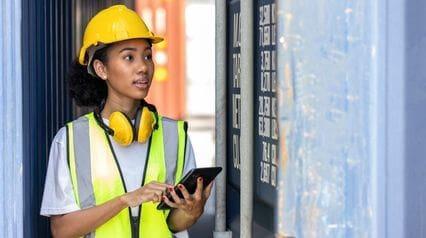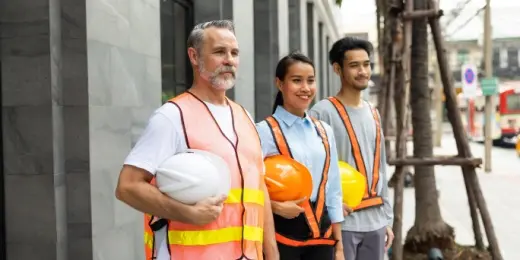What is a Lone Worker Alarm?
A lone worker alarm is a device that is used to send emergency alerts to a designated individual(s) in the event that a lone worker experiences an emergency.
From basic panic buttons to comprehensive lone worker safety solutions, there are many different types of lone worker alarms that offer a variety of functionality—and, therefore, different levels of safety.
On a rudimentary level, most lone worker alarms share two core features: panic activation and panic-site GPS coordinates. Basic lone worker alarm devices with only those features rely on the worker’s ability to physically activate their duress in an emergency and stay in the same exact location once they have done so.
On the other hand, more sophisticated (and therefore, effective) alarm solutions safeguard against a much wider range of emergency scenarios, with features such as real-time location monitoring, automated check-ins, overtime alerts, hazard reporting, safety checklists/forms, and more.
Does your organization employ staff who work alone or in isolation? If so, you should have a dedicated lone worker safety policy in place that requires the use of a lone worker safety solution.
Reasons for Triggering a Lone Worker Alarm
Employees may trigger their lone worker alarms for a variety of reasons.
Some of the most common lone worker hazards include:
- Working alone or in isolation, without supervision or backup support
- General accidents and injuries
- Physical violence
- Tripping, slipping, falling
- Working with dangerous machinery
- Working from height
- Working with dangerous substances
- Sudden health emergency (i.e., heart attack or heat stroke)
- Traffic accidents
- Being struck by moving objects
To understand common reasons why your employees might need to trigger their personal alarms, your organization should carry out a lone working risk assessment.
How Do You Keep Lone Workers Safe Using a Lone Worker Alarm?
To understand how deploying lone worker alarms across your workforce can make all the difference, consider these three common lone-working scenarios, first without, and then with, a lone worker alarm.
|
Scenario |
Without Lone Alarms |
With Lone Alarms |
|
A home healthcare nurse is visiting a patient. When trying to administer the patient’s medicine, the patient becomes verbally aggressive and threatens to hurt the nurse. |
The nurse begins to fear for their life. They try to de-escalate and exit the situation. In this scenario, all outcomes are possible. |
In that instant, the nurse swiftly and discreetly activates a panic alarm, notifying management of the emergency, who dispatches emergency assistance immediately. Then, the nurse attempts to de-escalate and exit the situation. If needed, police and paramedics are already on the way. |
|
A factory worker operates a forklift in isolation (out of sight and earshot of other workers). A serious forklift accident occurs. The worker is injured, stuck, and unable to move. They yell for help, but no one can hear them. |
Many hours pass by before another worker finds them and calls for help. |
According to the factory’s safety policy, workers are required to check -in automatically every 20 minutes on their lone worker devices. When the worker misses their next check-in, the on-site manager receives an alert to go check on the worker and immediately calls for help. |
|
A utility maintenance staff member is working from height in a remote location. They fall down and are knocked unconscious. They have sustained serious injuries, so receiving help is time-critical. |
Their accident will go unnoticed until they are either discovered by a passerby or their family members realize that they did not return home that evening. |
The lone worker device’s man-down/fall detection feature sends a duress alert to management. After the worker fails to confirm their wellbeing, emergency assistance is dispatched to their exact GPS coordinates. |
As you can see, having a simple yet effective lone worker solution in place ensures that employees can receive assistance when they need it most.
Which Alerts are Monitored by a Lone Worker Device or Alarm?
The types of alerts that can be triggered and monitored by a lone worker device vary by system. For a general understanding of an effective solution, consider SHEQSY by SafetyCulture:
SHEQSY’s comprehensive safety solution can be deployed across lone workforces via the SHEQSY lone worker smartphone app (iOS and Android), as well as integrated Bluetooth wearables and handheld satellite devices. Meanwhile, organizations can manage, monitor, and report on lone workers in real time via the cloud-based SHEQSY Dashboard.
Lone workers can activate their duress and trigger panic alerts in a number of ways via:
- The smartphone app’s “QuickPanic” widget
- The smartphone app’s “Shake for Panic” feature
- The smartphone app’s “PANIC” button
- An integrated Bluetooth device’s panic button
- An integrated Bluetooth device’s man-down/fall detection feature
- An integrated handheld satellite device’s panic button
In addition, automated check-in prompts can be sent to lone workers to check in at customized intervals. If lone workers fail to check in, overtime alerts or panic alerts can be triggered. After a specified overtime has lapsed, overtime alerts can trigger panic alerts.
These overtime and panic alerts can be monitored by your management teams or a 24/7 professional security monitoring center.
SHEQSY is completely customizable to suit your organization’s requirements and lone worker safety policy.
Is It Required by Law?
Every country has its own set of workplace health and safety laws, some more stringent than others.
Many governments worldwide, including Australia, New Zealand, Canada, and the United States, broadly require organizations to take responsibility for workers’ health and safety and take all practicable precautions to ensure safe workplaces.
For example, in Australia, all organizations must:
- provide safe ways of working;
- provide a safe work environment;
- provide any information, training, instruction, or supervision needed for safety; and
- monitor the health of workers and conditions at the workplace.
Meanwhile, some countries, such as the United Kingdom, have also published guidelines to protect lone and isolated workers and encourage the use of lone worker alarm systems.
The United Kingdom Health and Safety Executive’s guide, Protecting lone workers, states that technological advances have led to “a wide range of systems and devices available to employers to monitor lone workers.” Some communication solutions to safeguard lone workers may include:
- Pre-agreed intervals of regular contact between the lone worker and employer, using phones, radios, email, etc.
- Other devices designed to raise the alarm in an emergency, which can be operated manually or automatically
- Implementing a robust system to ensure a lone worker has returned to their base or home once their work is completed.
While a lone worker alarm may not be explicitly required by law, organizations are generally required to safeguard lone and isolated workers—and their work environments. The simplest, most effective way to be compliant, and have a digital audit trail, is with a lone worker alarm system.
FAQs About Lone Worker Alarms
A lone worker alarm is a system that enables employees who work alone or in isolated environments to communicate with a designated person(s) in the event of an emergency. Lone worker alarms can be triggered manually by the employee (usually, by pressing a panic button). In some cases, alarms can also be triggered automatically via built-in safeguards such as automated check-ins, overtime alerts, and man-down/fall-detection functionality.
Many lone worker alarm systems give organizations the option to either monitor panic alarms in-house or use a 24/7 professional security monitoring center to verify duress situations and coordinate emergency responses, based on the organizations’ safety policies.
There are 6 main risk categories involved in working alone:
- Working alone or in an isolated environment (especially without supervision or backup support)
- Physical violence (i.e. assault, robbery)
- Accidents and injuries (i.e. tripping, slipping, falling)
- Operational hazards (i.e. dangerous equipment, working from heights or in confined spaces)
- Environmental/workplace hazards (i.e. heavy traffic, dangerous gases and chemicals, fires, floods)
- Health emergencies (i.e. heart attack, heat stroke, pre-existing conditions)
Specific risks vary depending on the nature of the work and workplace. Organizations should be aware of the risks associated with working alone and have procedures in place to mitigate these risks. One of the best ways to do this is by implementing a lone worker alarm system that can provide emergency assistance in the event of an incident.
The main alert that is monitored by a lone worker device is a panic alarm, or a duress alarm. This type of alert is used in an emergency situation.
Some lone worker alarm systems, such as SHEQSY by SafetyCulture, also require employees to complete automated check-ins and send overtime alerts if they fail to do so. When employees are unresponsive for a certain time period, overtime alerts can turn into panic alerts.
Some lone worker devices also include man-down/fall-detection panic alerts, which can be triggered automatically, via wearable Bluetooth devices.
A personal panic button is the same thing as a lone worker alarm; it is a small, handheld device that lone workers can use to signal for help in an emergency. Personal panic buttons can be as simple as small pendant buttons (which can be worn or kept in a pocket) or as sophisticated as a lone worker safety smartphone app. When activated, a personal panic button sends a duress alarm to a designated person(s) or monitoring center. Some personal panic buttons include features like real-time location tracking and two-way communication, which can help emergency responders locate the person quickly and accurately.




